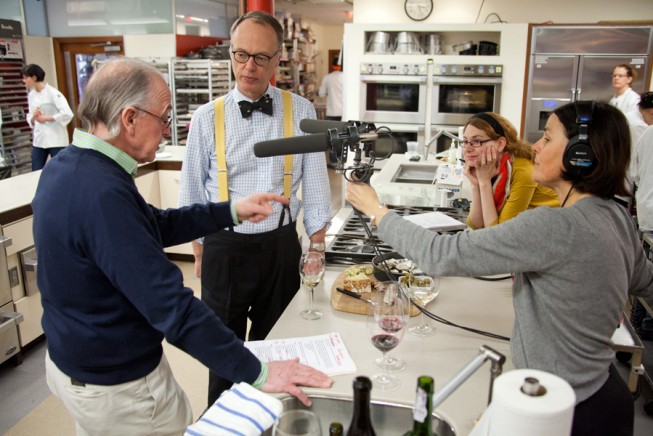
Judging from the questions I field every day in the wine department of Formaggio Kitchen in Cambridge and the mail I receive from America’s Test Kitchen Radio listeners, food and wine pairing continues to be a major cause of uncertainty and, frankly, anxiety.
My sense is that a significant part of the problem is a too-fussy approach to the topic in general. Your home is not a restaurant, and while it’s sensible to try to make the best choices you can, attempting to accomplish what a sommelier and a chef can do with their generous resources will likely be an exercise in frustration. Also, it’s worth remembering that in those places where wine is made, people get by just fine by matching what’s available from local vineyards with whatever’s on the table.
All of this is applicable when we take up the subject of matching wine with seafood dishes. To get started, let’s review the basic techniques professionals use to make successful food and wine pairings. There are really only three approaches, and they’re easy to remember. I use my own made-up terms to describe them.
1. Blood Relations. This is shorthand for the “if they grow together, they go together” technique. This just means that if you’re serving a dish that has a strong regional identity, pair it with a wine that comes from that same region.
2. Old Friends. This covers those pairings that share no regional connection but enjoy a relationship long hallowed by tradition.
3. Happy Hook-ups. No blood relationship or long-established friendship here—instead, some fortuitous discovery has brought the two together. You might have encountered the pairing at a restaurant, uncovered it for yourself, or received the recommendation from a friend. Somehow, it just clicks.
Let’s start with the first, the “if they grow together, they go together” category. Here are three wines that are all made in vineyards that edge the North Atlantic and have grown up together with the cuisines of those coastal communities.
- Vinho Verde. From Portugal, mostly from vineyards on its Atlantic coast. Light and superfresh, with lots of lively acidity and, often, a bit of spritz. Alcohol content rather low. Its classic pairing is with grilled sardines. You’ll love it with any sort of oily fish: sardines, mackerel, bluefish.
- Vermentino. Also known as Favorita or Pigato, the grape is most widely planted along the coastal rim formed by Tuscany, Liguria, Corsica and Sardinia and is consumed in hundreds of cafes and fish shacks through the area. Enjoy with whole grilled branzino.
- Muscadet. The vineyards of this French region lie in the area where the Loire empties into the North Atlantic. The style is light, dry, and tangy; many people detect a whiff of salty air in the glass. Pair with soft-shell crab and Ipswich clams—the small, tender mollusks New Englanders know as “steamers.”
In our on-air segment Chris tasted the Domaine de la Pépière Château-Thébaud “Clos des Morines” Muscadet Sevre et Maine, the Quinta de Raza Vinho Verde, and the Poderi Cellario Favorita.
Now for a couple of examples of wine and food pairings from category two, those that don’t owe their connection to growing up side by side but enjoy a long-standing relationship.
- Chablis. The Chablis region isn’t near any ocean, but there’s a long tradition of pairing its cool, racy whites with oysters. If we’re roasting a perfect piece of dry-fleshed white fish, such as halibut, haddock, or sole, this is likely what I’m reaching for.
- Blanc de blancs Champagne. The Champagne region isn’t far from Chablis, and it shares a similar soil type (the decomposed shells of sea creatures). For seafood I tend to prefer the all-Chardonnay bubblies known as blanc de blancs. Expect the same cool, racy character you find in Chablis—but with an extra kick that comes from those streaming columns of creamy bubbles. Swordfish, skate wing, and grilled Gulf shrimp are splendid pairings.
Chris tasted the Jean-Marc Brocard Sainte-Claire Chablis.
Finally, an example of a pairing that qualifies as neither a blood relation nor a “grows together, goes together,” nor, as far as I know, something of long-standing tradition.
Traditional German Riesling. The trace of sweetness that comes from leaving a bit of sugar unfermented in the bottle is what makes riesling from Germany so distinctive. Although the trend today seems to be toward a drier style, it’s the more traditional style in view here. The happy hook-up is with Maine lobster in any form: boiled, roasted, grilled, lobster salad in a top-loading hot dog bun—even bisque. It’s not my sense that there’s any history between these two, and I stumbled on the pairing a bit accidentally, but it’s pitch-perfect. Traditional German riesling is also splendid with succulent sweet-fleshed seafood such as crab, scallops, and monkfish.
Chris tasted the Donnhoff Nahe Estate Riesling.
There are many more delightful matches to be made in all three categories, of course. We haven’t even mentioned Sauvignon Blanc, Fino Sherry, the brisk Basque oddity Txakolina, Greek Assyrtiko, Gruner Veltliner and Chenin Blanc—all wonderful with seafood in their own right and rewarding to explore.
Stephen Meuse can be reached at stephenmeuse@icloud.com